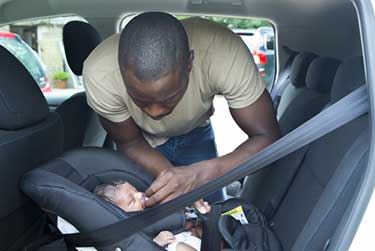
Written by Kayla Jane Barrie Updated on Nov 24, 2025 5 mins read

Ontario car seat regulations are in place to protect children in case of an accident. And as parents, we must take steps to ensure our children are safe when traveling in a vehicle. However, many parents are not up to date with the latest car seat laws. Most also fail to install car seats correctly.
Transport Canada sets the minimum requirement for car seat manufacturers. Stricter rules can be applied by province or territory, so take the time to know your local laws.
Strap in as we take you through car seat laws and regulations in Ontario to keep your children safe.
The Canadian Public Health Association says child car seats reduce the risk of death by 71% in infants under one year old and 54% for kids ages one to four.
All drivers are responsible for the safety of passengers under 16 years old. However, those under the age of eight require a car seat or booster specifically designed for their size and weight. Using the correct child seat is a way to prevent serious injuries to children in the event of an accident. Studies show that:
Each car seat stage is designed to protect passengers of every size. There are three primary types of car seats for children, each with distinct stages or styles. Once they graduate from the three car restraints, you can evaluate having them use a seatbelt (also known as stage four).
Stage 1: Rear facing car seat
Stage 2: Front facing car seat
Stage 3: Booster seat
Stage 4: Seat belt
Failure to properly or improperly secure a child in your care, you can be charged and fined up to $240 and two demerit points. According to the Highway Traffic Act, a car seat or booster seat must be used with children under eight years old.
Children can legally use a seatbelt when they reach the age, weight, or height limits set out by the province. In Ontario, they suggest that children under 12 are safest in the back seat.
Keep in mind that front seats have airbags, and when they inflate, they can cause injury. If a child is in the front seat, move the seat back as far as possible while leaving room for any passengers in the backseat, and make sure the child always sits up straight against the seat – they should never have their feet up on the dashboard or leaning against the door.
After a car accident, you can not use the same car seat even if your child was not in the car with you. This is the case even if there is no visible damage.
Many insurers will compensate you if you file a claim for a damaged car seat under comprehensive coverage. You will need to buy a new seat (it does not have to be the same type), and they will reimburse you.

If you have been in a crash and need to submit a claim for a damaged car seat under your comprehensive auto policy, here is what you will need to do:
Transport Canada outlines car seat expiry dates in Canada will vary between six to nine years. If a seat was made before January 1, 2012, it might be illegal to advertise or sell because it does not meet current safety requirements.
You should not use, buy or sell car seats after the expiry date because, over time, defects can occur, such as:
Here are the top car seat safety tips to help keep your children safe in the car:
Legally, even if you take a taxi or Uber, you must ensure your child has the proper car seat. Not all car seats fit specific cars, and your driver can deny your trip if you do not have proper accommodations for your child. Some drivers may not be comfortable with you installing it in their cars, either.
An expired car seat does not affect your auto insurance. However, it does put your child at risk for injuries and there are fines associated with the improper use of child seats. Make sure you are buying a car seat that meets current safety standards.
Generally, car seats and booster seats will expire after six to nine years, according to Transport Canada. Always confirm with the manufacturer's information. You should not use expired car seats because the safety standards have changed, and there are now safer products. Later owners may not get safety recall notices, labels on how to use are faded, and frequent use and exposure can weaken the plastic.
Once a child has outgrown their rear-facing car seat and is at least two years old, they can move into a forward-facing car seat with a five-point harness.
In Ontario, a child must weigh a minimum of 36 kilograms (80 lbs .) or more, be 145cm (4 feet 9 inches) tall or taller, and be over 8 years old to sit in the front.
After selecting the right car seat, install it properly and register it with the manufacturer. Combining this with comparing car insurance quotes every year will ensure your family is covered.
| Categories | Auto |
|---|---|
| Tags | Driving Tips |
Read our insurance blog to get helpful tips, information and news.
Has your car been totalled in an accident? Is your car a write off? Learn about vehicle write offs for a total loss insurance claim.
Get the facts on Toronto's auto theft problem. We break down the data, reveal the most-stolen vehicles (including the Honda CR-V and Lexus RX 350), and show which neighbourhoods are most affected.
Dive into the world of auto theft with our blog on the most stolen cars in Canada. See the most stolen cars across Canada, including provincial lists for Ontario and Quebec, and learn how high-risk models can affect your car insurance premiums.
Drive safe this winter! Check out these tips for driving in snowy and icy conditions in Ontario. Get other helpful info and FAQs on winter driving.